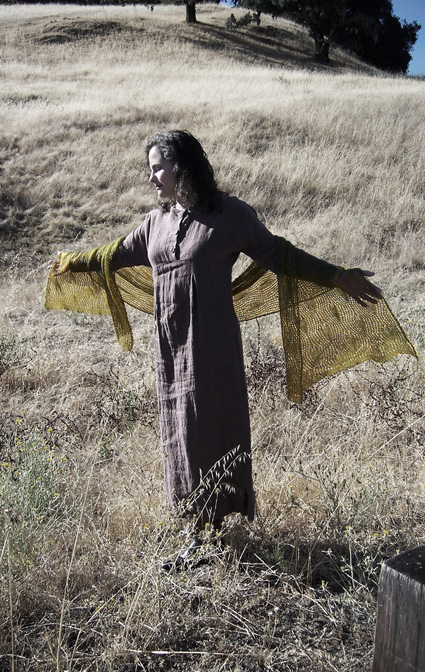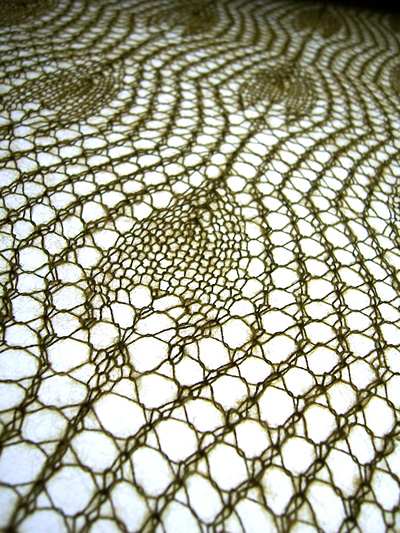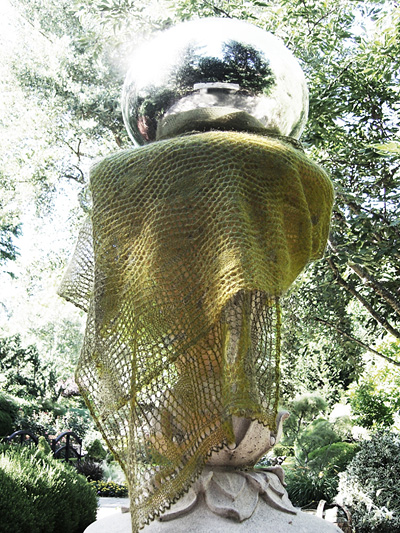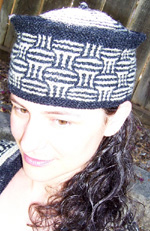|













![Read exactly what FREE PATTERNS really means...respect our designers and authors rights [and thank you]](../images/OFFnavLEGAL.gif)



 
|
 |
 <click
for more! <click
for more!
 
|

  by
Rosemary Hill by
Rosemary Hill

One of my favorite places in the world is Muir Woods in my native California, just north of San Francisco. But not because of the Redwood trees for which it is famous. It’s the smell of the California Bay Laurel tree that is forever etched in my mind.
Whenever I’ve gone through difficult times, I’ve retreated to Muir Woods, spending hours and hours there in my favorite grove: smelling the trees, watching the light flicker across the ground as the wind blows, listening to the water burbling across rocks. Perhaps that is why my favorite color turns out to be green, even though, for the longest time, I thought it was plummy purple.
This shawl, with its leaves and mesh pattern, reminds me of the light flickering through the Bay leaves in the most peaceful and lovely corner of my universe. I can almost smell it now! |  model: Rosemary
Hill model: Rosemary
Hill  photos: Clint
Holeman, Rosemary Hill photos: Clint
Holeman, Rosemary Hill
| | | |
|
| One |
|
|
Measurements taken after blocking.
Width: 22 inches
Length: 82 inches | |
|
 Artfibers Tsuki [40% silk/60% superkid mohair; 515yd/471m per 40g cone]; color: #04 Olive Green; 2 cones Artfibers Tsuki [40% silk/60% superkid mohair; 515yd/471m per 40g cone]; color: #04 Olive Green; 2 cones
 1 24-inch US #6/ 4mm circular needle 1 24-inch US #6/ 4mm circular needle
 Crochet hook, close in size to US G/6 / 4mm Crochet hook, close in size to US G/6 / 4mm
 Waste yarn Waste yarn
 Sewing needle Sewing needle | |
|
Approx. 24 sts/22rows = 4 inches in Lace pattern AFTER BLOCKING
Note: Correct gauge is not essential for this project. | |
|
[Knitty's list of standard abbreviations and techniques can be found here] |
  The
chart for this pattern is large. Please click here to
see the chart [now in PDF format].
It should print neatly on a single sheet of letter-sized
paper. The
chart for this pattern is large. Please click here to
see the chart [now in PDF format].
It should print neatly on a single sheet of letter-sized
paper.
Use the Russian Join to join yarn ends when necessary. Instructions
for the Russian Join can be found here.
Information about wet-blocking lace can be found here and here.
S2KP:
Slip next 2 sts together to right needle, as if working a k2tog;
k next st, pass slipped sts over.
SK2P: Slip next st knitwise, k2tog, pass slipped st over.
Make Picot: CO 2 sts using Knitted Cast On; k2tog tbl, k1 tbl, pass first st worked over second st as if binding off.
Crochet Cast On
Using waste yarn, work a crochet chain several sts longer than the number of sts to be cast on. Starting 1 or 2 sts in from end of chain and using working yarn, pick up and k 1 st in the back loop of each ch until the required number of sts have been picked up. Later, the chain will be unraveled and the resulting live sts picked up.
A tutorial for an alternate way to work the Crochet Cast
On can be found here.
If you use this method, k 1 row using the working yarn before
beginning to work the pattern.
| |
|
SHAWL BODY
Using Crochet Cast On, CO 125 sts. Leave a yarn tail at beginning of CO row, at least 6 inches long.
Work Rows 1-32 of Lace Chart 13 times, then work Rows 1 and 2 once more.
Pattern Repeat will be worked 3 times in each row.
  UPPER BORDER UPPER BORDER
Row 1 [RS]: K2, ssk, yo, k1 tbl, p to last 5 sts, k1 tbl, yo, k2tog, k2.
Row
2 [WS]: K all sts.
Row
3 [RS]: Make picot, k1, ssk, yo, k1 tbl, [yo, k2tog] to last 2 sts, k2.
Row
4 [WS]: Make picot, k to end.
Rows 5 & 6: K all sts.
Rows
7 & 8: Make picot, k to end.
Rows
9 & 10: K all sts.
BO as follows: [Make picot, BO 2 sts, sl st from right needle back to left needle] to end of row, making 1 picot at end of row. Break yarn and sew end into border so that last picot sits properly.
LOWER BORDER
Carefully remove waste yarn from CO edge, placing resulting live sts on needle. Join yarn to tail from CO using Russian Join. 125 sts on needle.
The next row is a bit tricky; try it out on a swatch first if you wish. It is intended to carry the 5-stitch border unbroken along the side, rather than having an obvious half stitch offset. It’s worth the effort!
Row 1 [RS]: P3, k1 but do not drop st from left needle, k2tog but drop only first st from left needle do not drop second st from needle, p2tog (second st of k2tog just worked is purled together with next st), p to last 6 sts, p1 but do not drop st from left needle, k2tog but drop only first st from left needle do not drop second st from needle, k1, p2, p2tog.
Row
2 [WS]: P2, p2tog, yo, p1 tbl, k to last 5 sts, p1 tbl, yo, p2tog, p2.
Row
3 [RS]: Make picot, p2, k2, [yo, k2tog] to last 6 sts, yo, k2tog, k1, p3.
Row
4 [WS]: Make picot, p1, p2tog, yo, p1 tbl, k to last 5 sts, p1 tbl, yo, p2tog, p2.
Work Rows
5-10 and BO as for Upper Border. | |
Sew
in any remaining ends.
Wet block shawl. Links to two excellent
articles about blocking lace can be found
in the Pattern Notes above.
If using blocking wires or string, thread
through columns of yarnovers along side edges
of shawl, and through both yarnovers and
picots at ends of shawl. | |
  Rosemary
(aka Romi) lives with three wonderful
men in wine country. In 2005 she became
a purveyor of shawl, scarf and sweater
pins when she launched Designs
by Romi, and since then it's
been taking up most of her time. Right
now, she's hard at work on a book for
Interweave Press on knit and crocheted
jewelry. She's just happy to be mixing
work with play! Rosemary
(aka Romi) lives with three wonderful
men in wine country. In 2005 she became
a purveyor of shawl, scarf and sweater
pins when she launched Designs
by Romi, and since then it's
been taking up most of her time. Right
now, she's hard at work on a book for
Interweave Press on knit and crocheted
jewelry. She's just happy to be mixing
work with play!
Drop by her
blog to see what she’s
up to these days! |
| Pattern & images © 2007 by:
Rosemary Hill. Contact Romi |
|
|
|
|
|

